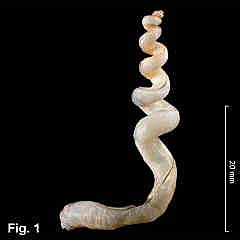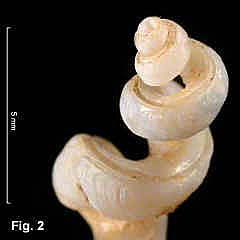|
|
|
|
|
Pyxipoma weldii (Tenison-Woods, 1875) Description: First two or three whorls sometimes regularly coiled, rest of shell loosely coiled or uncoiled. Whorls sculptured in part with faint longitudinal threads. Slit closed in early whorls leaving regular channel; open with straight sides on rest of shell. Aperture circular, lip thin and irregular. Interior smooth, white and polished. Colour white, yellowish or light pink. Size: Up to about 75 mm in length with tube diameter of 3 mm. Distribution: Australia and New Zealand; in Australia, from Caloundra, Queensland, around southern Australia to mid-west coast of WA, including Tasmania. Habitat: Subtidal, down to about 200 m. Common on beaches in Victoria and South Australia, uncommon in NSW. Morton (1951b) gave the following information about the habitat in New Zealand: "Pyxipoma weldii was obtained alive after an easterly gale at Milford, cast ashore from the sublittoral zone attached to the holdfasts of Ecklonia, where it is typically found embedded in a massive yellowish-white sponge. It is invariably an offshore species, frequently turning up in the trawl from a depth of several fathoms, and never found in the littoral zone. A single sponge may be thickly studded with several hundred shells, with the dome shaped opercula loaded with debris projecting above the surface." Comparison: This species can be distinguished from other members of the family by its smaller size and open, smooth-sided slit. Synonymy: No synonyms. Remarks: The anatomy, reproduction and radula of this species has been described in detail by Morton (1951b). Fig. 1: Rhyll, Westernport, Victoria, in 6 fathoms (11 m) (C.009268) Fig. 2: Same specimen as Fig.1 |

